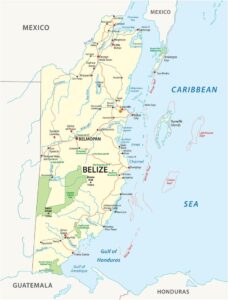Over the centuries, the territorial boundaries of Belize have been shaped by a complex and contentious historical narrative. You might find yourself wondering why the border between Belize and Guatemala appears as a dotted line on many maps. This visual representation highlights a deeply entrenched territorial dispute that has its roots in historical claims made by Guatemala, which has persistently contested Belize's sovereignty since the latter achieved independence. The risk of international tension remains high, as both nations are engaged in ongoing diplomatic negotiations aimed at resolving this boundary conflict. Your journey through this geopolitical conundrum unveils the intricate challenges that national borders pose in <a href="https://limitsofstrategy.com/belize-central-american-or-caribbean-settling-the-debate/">Central America</a>, where colonial legacies and notions of territorial integrity intersect in potentially volatile ways.
Delving into the Historical Claims Underpinning the Belize-Guatemala Dispute
The enduring territorial conflict between Belize and Guatemala has its roots in complex historical and colonial legacies that date back to earlier centuries. This dispute originates from the colonial era, a time when territorial boundaries were often vaguely defined and subject to interpretation. The ongoing unresolved border issue has persisted through the ages, creating continuous tension between these neighboring nations, which has adversely affected their diplomatic relations and interactions.

Unraveling Guatemala’s Historical Claims to Belizean Territory
Primarily, Guatemala has steadfastly asserted its historical claim to territorial rights over Belize, rooted deeply in the Spanish colonial administrative boundaries. It may come as a surprise that Guatemala views Belize as part of its original territorial inheritance from the Spanish Empire, which challenges the modern borders established during British colonial rule. This historical viewpoint continues to invigorate Guatemala’s claims and complicate the sovereignty debate.
Analyzing the Implications of Historical Borders on Modern Relations
Since the colonial period, these disputed boundaries have given rise to significant geopolitical challenges for both nations. You can observe how the undefined border regions create opportunities for conflict and diplomatic tensions, which ultimately impact local communities and national sovereignty. A comprehensive understanding of this border dispute reveals complex layers of historical, legal, and territorial dynamics. The consequences extend beyond mere geographical lines, encompassing economic, cultural, and security risks. The ongoing conflict has substantial implications for regional stability, international law, and the prospects for future negotiations between Belize and Guatemala.
Understanding the Significance of the Dotted Line on Maps
When you examine maps, you may notice a striking feature: a dotted boundary line between Belize and Guatemala, signifying a long-standing territorial dispute that has endured for decades. This distinctive cartographic representation indicates a complex geopolitical challenge, where the precise border remains undefined and contested. The dotted line serves as a symbol of the ongoing diplomatic tension and the unresolved territorial claims that have characterized the relationship between these two Central American nations for years.
International Recognition Amidst the Unresolved Border Dispute
In the context of international relations, Belize stands as a recognized sovereign state; however, the disputed border with Guatemala introduces a nuanced geopolitical landscape. You may find it intriguing that although Belize achieved independence in 1981, Guatemala has historically questioned its territorial integrity. The dotted line not only represents geographical uncertainty but also reflects an ongoing diplomatic negotiation that continuously shapes regional relations and perceptions.
The Diplomatic Weight of the Dotted Line Between Nations
Beyond its representation on maps, the dotted line emerges as a potent diplomatic symbol. You can interpret it as a visual manifestation of unresolved territorial claims, signaling to the international community the intricate negotiations between Belize and Guatemala. This unique border marking communicates the ongoing dialogue and the potential for a peaceful resolution to the conflict. However, the dotted line embodies more than mere cartographic interest; it represents a delicate diplomatic instrument that aids in preventing possible military escalation while keeping open channels for negotiation.
This line serves as a strategic buffer, allowing both countries to maintain diplomatic relations and work towards a feasible resolution. Its existence exemplifies how international borders can be managed through peaceful means, showcasing a sophisticated approach to resolving territorial disputes that prioritizes dialogue over confrontation.

Investigating Key Conflicts and Diplomatic Agreements Between Belize and Guatemala
The territorial disputes between Belize and Guatemala are deeply entrenched in history, characterized by complex diplomatic tensions and unresolved boundary claims. As you delve deeper, you’ll discover that the ongoing disagreement revolves around competing interpretations of colonial-era treaties and the notion of territorial sovereignty. This dispute has far-reaching implications for both nations, encompassing potential land ownership challenges and regional geopolitical dynamics that continue to influence their relationship.
Understanding the Impact of the 1859 Treaty and Its Aftermath
Before the signing of the 1859 treaty between Britain and Guatemala, territorial boundaries in the region were ambiguous and fiercely contested. It’s essential to recognize that this agreement aimed to establish clear borders, yet subsequent interpretations led to ongoing disputes. Guatemala has consistently questioned the validity of the treaty, claiming that Britain failed to fulfill specific commitments regarding infrastructure development, which has become a core point of contention in their territorial disagreement.
International Court of Justice's Role and Recent Diplomatic Initiatives
Recent diplomatic efforts have focused on resolving the long-standing border dispute through international legal avenues. You’ll note that both nations have agreed to present their case to the International Court of Justice (ICJ) for a binding resolution. This approach signifies a crucial step toward peaceful conflict resolution and the potential normalization of bilateral relations.
Alongside the ICJ proceedings, it’s important to recognize the intricate diplomatic negotiations that have unfolded. The potential referendum in both countries to validate the ICJ’s decision represents a unique strategy for resolving territorial disputes. Your understanding of this process highlights the delicate diplomatic efforts aimed at maintaining regional stability and addressing historical territorial claims through peaceful, internationally recognized mechanisms.
Assessing the Current Situation and Travel Considerations for Tourists
Many travelers are captivated by Belize’s unique border configuration with Guatemala. The ongoing territorial dispute has fostered a complex geopolitical landscape that significantly affects travel and border crossings. Despite existing tensions, tourists continue to visit both nations, navigating the delicate diplomatic situation while being mindful of international boundaries and local regulations.
Essential Guidelines for Safely Crossing the Border Between Belize and Guatemala
When preparing for international travel to Belize, it’s vital to plan meticulously and adhere to these important guidelines:
- Make sure to carry a valid passport and any required travel documents
- Stay updated on the current state of diplomatic relations before commencing your journey
- Acquire suitable travel insurance for your trip
- Stay informed about border crossing procedures to prevent complications
The most crucial aspect is to remain aware of your surroundings and respect local regulations to ensure a smooth travel experience.
Community Perspectives and Local Insights on the Dispute
At the heart of the border dispute lie entrenched historical tensions and complex cultural dynamics. Communities situated near the border experience the direct effects of the dispute, with generational memories of conflict deeply influencing their perspectives. Residents often navigate a delicate balance between national pride and a yearning for peaceful coexistence, emphasizing the human dimension of this geopolitical issue.
Gaining In-Depth Insights into Community Dynamics Near the Border
To genuinely grasp the local perspective, it’s essential to explore the intricate landscape of cultural identity. You’ll find that border communities have developed distinct survival strategies, blending resilience with diplomatic pragmatism. Indigenous groups, in particular, play a pivotal role in nurturing cross-border relationships, often transcending official diplomatic tensions through grassroots connections and shared cultural experiences, fostering a sense of unity amid conflict.

Exploring Future Implications of the Belize-Guatemala Border Dispute
Despite the ongoing territorial dispute, there exists a significant potential for geopolitical shifts. The unresolved border issue between Belize and Guatemala continues to cultivate tension, with ramifications that could reshape diplomatic relations in Central America. You might observe that resolving this dispute could have profound effects on regional stability, economic cooperation, and the international perceptions of both nations.
Continuing the Dialogue Between Belize and Guatemala
Dialogue remains the primary strategy for addressing the territorial disagreement. You will find that both countries have been actively engaged in diplomatic negotiations, striving for peaceful resolutions through international platforms like the Organization of American States (OAS). These discussions signify a commitment to avoiding military confrontation and finding a mutually acceptable solution to their enduring border dispute, underscoring the importance of dialogue in conflict resolution.
Investigating Potential Pathways Toward Resolution
Above all, it’s crucial to recognize that numerous strategies exist for resolving the border conflict. International mediation and bilateral negotiations represent viable avenues for progress. You might consider approaches such as joint territorial management, referendums, or interventions from international courts as potential methods to effectively address the dispute.
The implications of resolving the conflict extend far beyond simple boundary demarcation. You will discover that successful negotiations could unlock significant economic opportunities for both Belize and Guatemala, leading to enhanced trade, improved cross-border cooperation, and increased foreign investment. The most transformative outcome would be establishing permanent territorial sovereignty, which could dramatically ease regional tensions and promote long-term stability in Central America.
Understanding the Regional Dynamics of the Belize-Guatemala Conflict
Unlike other border disputes in Central America, the Belize-Guatemala territorial conflict is steeped in deep historical complexities that have significantly shaped regional geopolitical interactions. You’ll find that this longstanding disagreement reflects broader patterns of territorial tension, involving colonial legacies, post-independence territorial claims, and intricate diplomatic negotiations that have profoundly influenced the political landscape of the region.
The Impact of the Dispute on Central American Relations
After decades of territorial disputes, you can observe how this conflict has strained diplomatic relationships between Belize and Guatemala. The ongoing tension has periodically disrupted regional cooperation, creating challenges for economic integration and mutual understanding within the broader Central American community.
The Role of International Organizations in Mediation Efforts
With diplomatic mediation playing a crucial role, international organizations have actively engaged in efforts to resolve the border dispute. You’ll note that entities such as the Organization of American States (OAS) have been instrumental in facilitating dialogue and proposing practical resolution strategies.
A comprehensive network of international organizations has been strategically involved in addressing the Belize-Guatemala border dispute. The United Nations, OAS, and various diplomatic channels have worked tirelessly to prevent escalation, offering mediation services and promoting peaceful negotiation. You’ll appreciate how these organizations have helped maintain stability, providing a structured approach to resolving territorial disagreements and mitigating potential military confrontations.
Reflecting on the Complexities of the Belize-Guatemala Border Dispute
Weaving together the complex threads of Belize’s territorial history, you can see how the nation’s border with Guatemala serves as a testament to unresolved colonial legacies. As you explore this geopolitical puzzle, you’ll come to understand that the dotted border represents more than a simple cartographic curiosity; it symbolizes ongoing diplomatic negotiations and historical tensions. Your comprehension of this dispute reveals the intricate challenges facing post-colonial states, where territorial boundaries continue to ignite international dialogue. The unresolved status underscores the delicate balance between historical claims and modern diplomatic resolutions, inviting you to appreciate the nuanced complexity of international border disputes.

Common Questions Regarding the Belize-Guatemala Border Dispute
What is the reason behind the dotted border between Belize and Guatemala?
The dotted border signifies a long-standing territorial dispute between Belize and Guatemala, originating from conflicts dating back to the colonial era. Spain initially claimed the territory, and following Belize's independence from Britain in 1981, Guatemala continued to assert its territorial claims, resulting in an undefined border demarcation depicted by the characteristic dotted line on maps.
Has the border dispute between Belize and Guatemala reached a resolution?
The dispute remains partially unresolved; however, significant progress has been achieved. In 2019, both countries agreed to submit the territorial disagreement to the International Court of Justice (ICJ) for a binding resolution. A referendum in both nations endorsed this approach, indicating a diplomatic pathway toward definitively settling the border controversy.
What are the historical origins of the border conflict between Belize and Guatemala?
The conflict originates from the 1859 treaty between Britain and Guatemala, which pledged infrastructure development in exchange for territorial recognition. When Britain failed to fully meet these obligations, Guatemala began to challenge Belize’s territorial integrity. This historical misunderstanding has perpetuated decades of tension, with Guatemala maintaining claims over approximately 53% of Belize’s current national territory.
The Article Why Is Belize’s Border Dotted? Exploring the Guatemala Dispute appeared first on Belize Travel Guide
The Article Belize’s Border Dotted: Unraveling the Guatemala Dispute Was Found On https://limitsofstrategy.com

